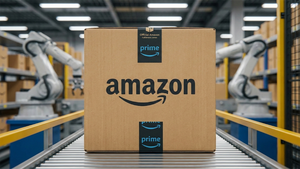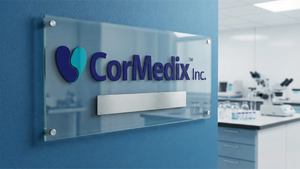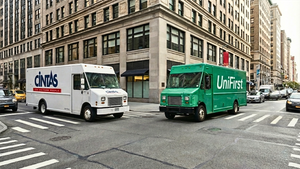
San Francisco, CA – November 4, 2025 – Uber Technologies Inc. (NYSE: UBER) emerged as a significant stock market mover today, experiencing a notable decline in its share price following the release of its Third Quarter 2025 earnings report. Despite showcasing robust growth in gross bookings, revenue, and trip volumes, the ride-hailing and food delivery giant failed to meet Wall Street's profitability expectations and offered a slightly more conservative outlook for its fourth-quarter adjusted earnings before interest, taxes, depreciation, and amortization (EBITDA). This mixed financial picture led to a swift negative reaction from investors, pushing Uber's stock down by approximately 6% to 9% in early trading.
The market's immediate response highlights a continued focus on profitability as a key metric for tech giants, even amidst impressive top-line expansion. While Uber reported record Adjusted EBITDA and free cash flow, a substantial legal charge and a non-recurring tax valuation benefit that significantly inflated GAAP net income overshadowed the underlying operational performance. This confluence of factors created a scenario where strong growth wasn't enough to satisfy investor appetite for a "cleaner beat" across all financial indicators, signaling a more discerning market environment.
The Q3 2025 Report: A Closer Look at the Numbers
Uber's Third Quarter 2025 earnings report, released before market open on November 4, 2025, painted a picture of robust top-line expansion coupled with underlying profitability challenges. The company reported total revenue of $13.5 billion, a solid 20% year-over-year (YoY) increase, surpassing analyst estimates of $13.28 billion. Gross Bookings also surged by an impressive 21% YoY to $49.7 billion, with both Mobility and Delivery segments contributing significantly to this growth. Mobility Gross Bookings hit $25.11 billion (up 20% YoY), while Delivery Gross Bookings rose to $23.32 billion (up 25% YoY). Furthermore, Uber achieved a record 3.5 billion trips during the quarter, representing a 22% YoY increase, and saw its Monthly Active Platform Consumers (MAPCs) grow by 17% YoY.
Despite these strong operational metrics, profitability proved to be a sticking point for investors. While Uber reported a GAAP net income of $6.6 billion, or $3.11 per share, this figure was heavily influenced by a substantial $4.9 billion benefit from a tax valuation release and a $1.5 billion net benefit (pre-tax) from revaluations of its equity investments. More critically, the company's Income from Operations came in at $1.1 billion, growing only 5% YoY and falling significantly short of analysts' expectations of $1.62 billion. This shortfall was largely attributed to a $479 million legal cost related to "undisclosed legal and regulatory matters" and an 88% rise in General and Administrative (G&A) expenses. Adjusted EBITDA, a key profitability metric, increased by 33% YoY to $2.3 billion, with a 4.5% margin, but still narrowly missed some consensus estimates.
The timeline leading up to this market movement was straightforward. Uber announced the earnings release date in early October, culminating in today's report and subsequent investor call. Key players involved include CEO Dara Khosrowshahi, who emphasized the company's "high gear" growth and strategic investments, and CFO Prashanth Mahendra-Rajah, who highlighted record profitability while acknowledging the impact of legal costs. The initial market reaction was swift and negative; Uber's stock (NYSE: UBER) dropped by approximately 6% to 9% in premarket and midday trading. This downturn was a clear signal that the market prioritized the miss on operational profitability and the complex nature of the reported net income over the otherwise stellar top-line performance. The slightly cautious guidance for Q4 2025 Adjusted EBITDA, which came in just below analyst averages, further fueled investor apprehension.
Industry Ripple Effects: Winners and Losers
Uber's Q3 2025 performance, while mixed in terms of investor sentiment, sends clear signals across the competitive landscape of the gig economy and logistics sectors. Its continued robust growth in bookings and revenue, coupled with record Adjusted EBITDA, reinforces its market leadership but also intensifies pressure on rivals and creates significant opportunities for its strategic partners.
Direct competitors in the ridesharing space, most notably Lyft (NASDAQ: LYFT), are likely to face increased scrutiny. If Lyft's upcoming earnings reports do not demonstrate comparable growth or a clearer path to sustainable profitability, its stock could underperform relative to Uber's long-term trajectory. Similarly, global ridesharing players such as Didi Chuxing (NYSE: DIDI) in China, Grab (NASDAQ: GRAB) in Southeast Asia, and Bolt in Europe, will feel the intensified competition as Uber's financial strength enables further investment in technology, driver incentives, and market expansion, potentially eroding their local market shares.
In the highly competitive food delivery sector, Uber Eats' strong performance within Uber's overall results signals continued market share gains, putting rivals like DoorDash (NASDAQ: DASH), Grubhub (NYSE: TKWY, part of Just Eat Takeaway.com), and Deliveroo (LON: ROO) on the defensive. DoorDash, as Uber Eats' primary competitor in the U.S., may need to escalate marketing expenditures or promotions, potentially impacting its own margins and stock performance. The logistics arm, Uber Freight, also poses a growing challenge to traditional freight brokerage companies such as C.H. Robinson (NASDAQ: CHRW) and XPO Logistics (NYSE: XPO), pushing them to accelerate their digital transformation efforts to remain competitive against Uber's tech-first approach.
Conversely, Uber's strong financial footing represents a significant "win" for its strategic partners. Companies like Avride, with whom Uber recently announced a multiyear partnership for autonomous delivery robots, stand to benefit immensely from accelerated deployment and expanded reach. Similarly, collaborations with autonomous vehicle solution providers such as Momenta and Pony.ai, aimed at deploying robotaxi fleets, will likely see faster development and deployment schedules, creating substantial revenue opportunities for these partners. Electric vehicle manufacturers, including BYD Co. Ltd. (HKEX: 1211; SZSE: 002594), also gain from Uber's financial health, as it facilitates the company's commitment to bringing 100,000 new BYD EVs onto its platform globally, driving sales and market penetration for the automaker. Retail and event partners like Costco (NASDAQ: COST) and Live Nation (NYSE: LYV) will also see increased value from their integrations with Uber's robust delivery and mobility network.
Broader Industry Trends and Implications
Uber's Q3 2025 earnings report, while generating immediate stock volatility, offers a critical lens through which to view the broader trajectory of the gig economy, ride-hailing, and food delivery sectors. The company's continued growth in core metrics underscores the persistent demand for on-demand services, a trend that is expected to see the gig economy potentially comprise nearly 50% of the U.S. workforce by 2025, with global market values soaring. This expansion is fueled by technological advancements, evolving workforce expectations for flexibility, and the global pursuit of supplementary income.
The ride-hailing sector itself is in a period of rapid growth, driven by increasing urbanization and smartphone adoption. Uber, with its dominant market share (approximately 76% of U.S. rideshare spending), is a bellwether for trends such as the widespread adoption of electric vehicles (EVs), the integration of autonomous vehicles (AVs), and enhanced safety measures. Similarly, the online food delivery market continues its substantial growth, propelled by mobile penetration and changing consumer habits. However, this sector faces challenges including high commission fees, operational costs, and intense competition, pushing players towards autonomous delivery, direct-to-consumer models, and ghost kitchens.
The ripple effects of Uber's performance extend far beyond its immediate competitors. While strong results intensify pressure on rivals like Lyft (NASDAQ: LYFT) and DoorDash (NASDAQ: DASH) to demonstrate comparable growth and profitability, they also empower Uber to invest further in its ecosystem. For partners, including the vast network of drivers, couriers, and restaurants, Uber's financial health can dictate incentive structures, commission rates, and the adoption of new technologies. Positive earnings might enable better benefits for gig workers, potentially mitigating ongoing labor disputes, whereas cost-cutting measures could exacerbate dissatisfaction.
Regulatory scrutiny remains a persistent and growing challenge across the gig economy. The debate over worker classification (employee vs. independent contractor) is central, with legislative developments like the EU's Platform Work Directive, set for implementation by mid-2025, mandating clearer classification rules. Uber's ability to absorb increased labor costs, if reclassification occurs, is directly tied to its profitability. Furthermore, calls for algorithmic transparency in worker management and potential antitrust scrutiny, given Uber's market dominance, are ongoing concerns. Historically, Uber's journey from significant losses to consistent profitability in recent years highlights its strategic diversification into food delivery and freight, as well as its persistent investment in autonomous vehicles and AI as long-term solutions for efficiency and profitability, mirroring broader tech industry trends.
What Comes Next: Navigating Future Horizons
Following its Q3 2025 earnings report, Uber Technologies (NYSE: UBER) stands at a pivotal juncture, poised between sustained growth in its core businesses and the transformative potential of emerging technologies. In the short term, the company will likely prioritize reinforcing its market leadership in Mobility and Delivery, leveraging AI and machine learning to further optimize ride-matching, personalize recommendations, and enhance operational efficiency. This focus on streamlining logistics and reducing costs is crucial for improving profitability and addressing the margin pressures highlighted in the recent earnings. Simultaneously, Uber must continue to adeptly navigate ongoing regulatory challenges, particularly regarding driver classification and local operating restrictions, which remain significant short-term hurdles that could necessitate adaptations to its labor model.
Looking further ahead, Uber's long-term strategy is anchored in ambitious technological integration and diversification. A critical pivot involves the widespread deployment of autonomous vehicles (AVs), with plans to integrate AVs into its mobility and delivery networks in at least ten cities by the end of 2026, aiming for a significant fleet of self-driving cars by 2027. This "hybrid future" combining human drivers with Level 4 AVs promises substantial long-term operational cost reductions. Beyond AVs, Uber is committed to evolving into a "super app" model, expanding its offerings beyond ride-hailing to include grocery delivery, drone delivery, and potentially even electric vertical take-off and landing (eVTOL) technology, aiming to capture a larger share of consumer spending and enhance user retention. Geographic and service expansion, particularly in high-growth emerging economies, and the growth of its B2B "Uber for Business" platform, are also key long-term objectives.
The market opportunities for Uber are substantial, driven by the projected growth of the global ride-sharing, food delivery, and grocery delivery markets. Increasing urbanization, technological advancements, and a growing consumer preference for convenience create a fertile ground for Uber's multi-modal transportation and logistics solutions. Furthermore, the global push for sustainability presents an opportunity for Uber to lead in EV adoption within its fleet. However, significant challenges persist, including intense competition from rivals like Lyft (NASDAQ: LYFT) and DoorDash (NASDAQ: DASH), ongoing regulatory scrutiny that could impact its business model and costs, and the inherent complexities and high capital expenditures associated with deploying autonomous vehicles at scale. The unproven economics of robotaxi operations and the need to maintain robust cybersecurity and safety protocols also remain critical concerns.
Potential scenarios range from continued diversified growth with successful AV integration, leading to sustained profitability and market dominance, to a more challenging path defined by regulatory headwinds and AV deployment delays, which could constrain profitability and impact investor confidence. An accelerated AV adoption could, conversely, lead to significant market disruption, allowing Uber to offer highly competitive pricing and solidify its position as a dominant mobility and logistics platform. The company's ability to effectively manage these opportunities and challenges, while strategically investing in innovation and navigating the evolving regulatory landscape, will define its trajectory in the coming years.
Comprehensive Wrap-up: Assessing the Road Ahead
Uber's Q3 2025 earnings report, while met with an immediate dip in stock price due to specific profitability misses, fundamentally underscores its successful transformation into a profitable, cash-generative enterprise. The key takeaways reveal a company firing on all cylinders in terms of operational growth: accelerated trips and gross bookings, particularly in Mobility and Delivery, reached their fastest pace in over two years. Crucially, Uber achieved record Adjusted EBITDA of $2.3 billion, showcasing robust operating leverage and a healthy 4.5% margin, alongside a record $2.2 billion in free cash flow. The expanding Uber One membership program, now boasting 36 million members, and the significant growth in cross-platform users are vital for building a sticky ecosystem and boosting customer lifetime value.
Moving forward, the market's assessment of Uber will likely balance its undeniable growth momentum with a closer scrutiny of its underlying profitability and strategic execution. While the impact of the $479 million legal charge and a slightly conservative Q4 Adjusted EBITDA outlook caused immediate investor apprehension, the underlying business fundamentals remain strong. Uber's strategic priorities, including multi-product engagement, scaling autonomous technology, and aggressive expansion into grocery and retail delivery, position it for diversified revenue streams and enhanced market leadership in the evolving local commerce and transportation landscapes. The rapid acceleration of grocery and retail delivery, now surpassing restaurant delivery growth and contributing positive variable margins, indicates a significant new growth vector for the company.
The lasting impact of this period for Uber is its solidified position as a dominant force in the global gig economy, demonstrating that a path to profitability is achievable even for capital-intensive, high-growth tech platforms. Its strategic investments in autonomous vehicles, exemplified by partnerships with Nvidia (NASDAQ: NVDA) and Stellantis (NYSE: STLA), are not merely speculative but are actively being integrated to create a "hybrid future" that promises long-term efficiency gains. While legal and regulatory challenges will persist, Uber's strong financial health provides it with the resources to navigate these complexities. The company's ability to consistently deliver affordability for consumers while generating strong operating leverage highlights its maturity and strategic acumen in a dynamic market.
For investors, the coming months will require close observation of several critical indicators. Beyond the Q4 2025 performance against guidance, investors should monitor any further developments regarding the "undisclosed legal and regulatory matters" that impacted Q3's reported profit. Progress in autonomous vehicle integration and scaling, particularly the deployment and impact of AVs in key markets, will be crucial for long-term cost reduction and efficiency. The continued growth and profitability of the grocery and retail delivery segment, alongside the expansion and engagement of the Uber One membership program, will signal the success of Uber's diversification and customer retention strategies. Finally, watching the competitive landscape, particularly the performance of rivals like Lyft (NASDAQ: LYFT), will provide context for Uber's relative strength in the broader market.
This content is intended for informational purposes only and is not financial advice





